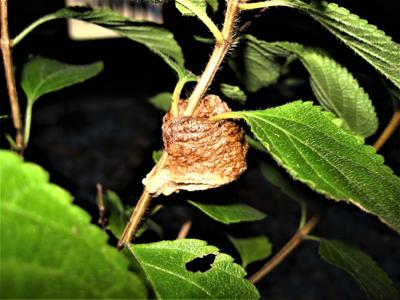Nature News | Marlene A. Condon February 5, 2022

Have you ever wondered where insects go in winter? Many kinds get through the cold months as eggs, some of which you may be able to find.
Adult females lay eggs before dying, and a new generation then awaits warm weather so that it can hatch out. Some eggs may be just about impossible for humans to find because they are so tiny and well hidden. An example would be walkingstick eggs.
An adult female drops them from tree level to the ground in late fall. The eggs are minuscule and become covered by leaves, or at least that’s what’s supposed to happen. Rake the leaves to send to the landfill or burn, and you destroy your walkingsticks. Thus, whenever possible, leaves should be left in place to serve as the natural mulch Mother Nature intended them to be.
Other insect eggs are much easier to spot because the female keeps them together in a casing of some sort. The praying mantis is one such example. As the female lays the eggs, she also secretes a foamy material that envelops them. When she’s done, the covering dries and looks just like meringue! This egg case, whose shape sometimes reminds me of a distorted church bell, contains about 200 eggs.
Although these egg cases are usually attached to flower stems or to twigs of bushes or small trees, you might find them almost anywhere. One fall day I noticed a praying mantis just after she had laid eggs at the top of a window frame on my porch. Later I was luckier and chanced upon a mantis in the process of laying eggs on the light fixture by my cellar door. I was delighted because I had never witnessed this before and I had wondered how the unusually shaped egg cases were made. The female simply moves her abdomen (this is where her egg-laying apparatus is located) in a circular motion, just as is indicated by the swirls that are visible on the bottom of dried egg cases.
Egg cases come in a variety of shapes and sizes, and you can locate some of them by using clues. The familiar Eastern Tent Caterpillars (that mature into moths) especially love apple and wild cherry trees, and their summer webbing or “tents” are often visible on these trees even now. If you check the smaller twigs of such trees, you will probably locate an egg mass. The egg mass can be up to 19mm (about ¾ inches) long and will encircle a stem (the shape reminds me of a corndog!). It will be hard, shiny, and very black. If you look closely, you will see it looks foamy, which is exactly what it was before it dried. There are between 150 and 350 eggs encased in that water- and cold-proof material.
It’s fun to look for insect eggs, but please, do leave them in place. Many of our insect species are dwindling in number so we shouldn’t interfere in order to perpetuate life.
